How did European cities get their human-centric streets and public spaces? Why could they escape the car-dependent status quo, while North America seemingly can’t?
There's one EASY trick planners and engineers don't want you to know about: Street Experiments. 🧵 1/
There's one EASY trick planners and engineers don't want you to know about: Street Experiments. 🧵 1/

Often, “good urbanism” in European cities is attributed to historical, cultural, or geographic factors - things out of our control. This assumption is wrong: the built form of a city is a DIRECT result of conscious decisions made by people.
So first, let’s dispel some myths: 2/
So first, let’s dispel some myths: 2/
Myth #1: “Euro cities are just old”
Many Euro cities were destroyed in WW2. ‘Old’ city centers are often rebuilds of historic city plans, as was in the case of Munich.
Other cities, like Rotterdam, were damaged so badly they were completely rebuilt from scratch. 3/

Many Euro cities were destroyed in WW2. ‘Old’ city centers are often rebuilds of historic city plans, as was in the case of Munich.
Other cities, like Rotterdam, were damaged so badly they were completely rebuilt from scratch. 3/


Myth #2: “They were built before the car”
1950s planners sought the ‘modernity’ of American postwar development - shoving cars into dense cities wherever possible. Public plazas turned into parking (Top: Gouda) and streets were repurposed for car movement (Bottom: Munich). 4/



1950s planners sought the ‘modernity’ of American postwar development - shoving cars into dense cities wherever possible. Public plazas turned into parking (Top: Gouda) and streets were repurposed for car movement (Bottom: Munich). 4/
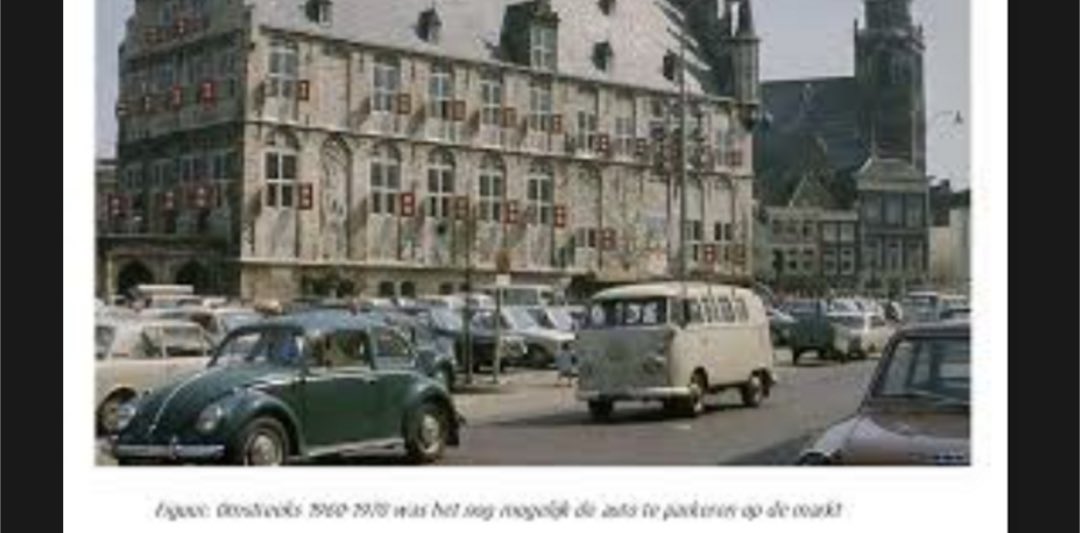



This pattern of postwar suburbanization came with urban issues similar to that of NA (though not the same extent). Swaths of urban space were repurposed for moving and storing cars, causing decay and disinvestment in inner cities. These plans received scrutiny and opposition: 5/ 
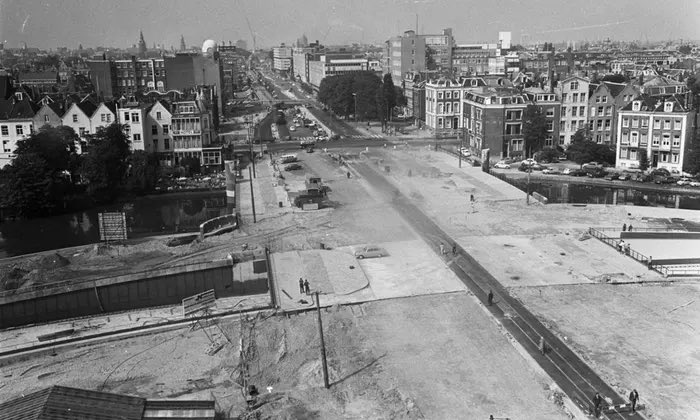
Like Jane Jacobs fighting Moses’ NYC highway plans, Europe had its share of movements against authoritarian car-centric planning.
To solve the congestion of 1960s Amsterdam, planners introduced a massive highway plan, “Plan Jokinen,” set to demolish historic neighborhoods. 6/
To solve the congestion of 1960s Amsterdam, planners introduced a massive highway plan, “Plan Jokinen,” set to demolish historic neighborhoods. 6/

Car-centric policy eventually sparked “Stop de Kindermoord” - literally “stop child murder” - a massive protest movement against traffic violence (and heavily influenced NL “sustainable safety” traffic policies). Similar demonstrations were held in other cities as a reaction. 7/ 



Calls grew louder for a more democratic system of city planning - so cities turned to direct voting on urban issues.
In 1993, Groningen (NL) held a controversial referendum - whether a road through the main city park should be closed to traffic for pedestrians and cyclists. 8/
In 1993, Groningen (NL) held a controversial referendum - whether a road through the main city park should be closed to traffic for pedestrians and cyclists. 8/

The result? 51%-49% voted in favor - a decision so pivotal that Groningen later became the nation’s leader in sustainable urban mobility.
The cycling revolution in the Netherlands could’ve never happened - if just 1% of people voted differently. 9/

The cycling revolution in the Netherlands could’ve never happened - if just 1% of people voted differently. 9/
https://twitter.com/gem_groningen/status/1185169335737901056?s=20

Today, the VAST majority of residents would argue that re-opening the park to traffic would be pure insanity - It has become one of the most popular public spaces and cycling links.
Groningen still stands as one of the largest indictments of public participation in planning. 10/
Groningen still stands as one of the largest indictments of public participation in planning. 10/

Clearly, there’s a delicate balance to be struck between democracy and autocracy. Planners are the experts, but can’t always tell communities what to do.
Too decisive - you risk a Le Corbusier. Too open-ended - you risk NIMBYism.
The solution? Street Experiments. 11/

Too decisive - you risk a Le Corbusier. Too open-ended - you risk NIMBYism.
The solution? Street Experiments. 11/
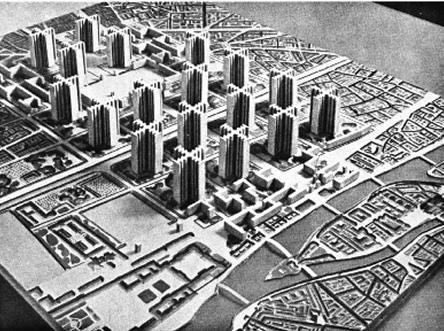

In August, I had the privilege of spending two weeks in Europe learning about street experiments with @RGAccessibility , @humankindcity , and @fietsprofessor .
I now strongly believe they are the single MOST effective tool for rapid urban change and public participation: 12/


I now strongly believe they are the single MOST effective tool for rapid urban change and public participation: 12/



Street Experiments are TEMPORARY and LOW-COST changes to the urban realm, usually reallocating space used by private cars for other forms of mobility or activity.
*Experiment* is the key: disruptive changes to urban space can be tested without significant commitment. 13/
*Experiment* is the key: disruptive changes to urban space can be tested without significant commitment. 13/
“𝐓𝐞𝐦𝐩𝐨𝐫𝐚𝐫𝐲” 𝐢𝐬 𝐢𝐭𝐬 𝐠𝐫𝐞𝐚𝐭𝐞𝐬𝐭 𝐬𝐭𝐫𝐞𝐧𝐠𝐭𝐡:
Experiments are cheap and quick to implement. What matters isn’t quality, but the reallocation of space for other uses.
It’s easy to sell to the public on temporary measures; if it doesn’t work, remove it! 14/
Experiments are cheap and quick to implement. What matters isn’t quality, but the reallocation of space for other uses.
It’s easy to sell to the public on temporary measures; if it doesn’t work, remove it! 14/
Here’s a “schanigarten” (outdoor patio) in Munich. Simple benches and tables have turned subsidized street parking into economically productive dining space.
Integrating the restaurant and blurring the lines between private & public, the street is made lively and inviting. 15/

Integrating the restaurant and blurring the lines between private & public, the street is made lively and inviting. 15/


𝐀 𝐩𝐨𝐰𝐞𝐫𝐟𝐮𝐥 𝐭𝐨𝐨𝐥 𝐭𝐨 𝐫𝐞𝐢𝐦𝐚𝐠𝐢𝐧𝐞 𝐩𝐮𝐛𝐥𝐢𝐜 𝐬𝐩𝐚𝐜𝐞:
Unlike abstract renders or public consultations, change is made TANGIBLE with an experiment. Planners/residents can physically test & observe effects, visualizing in real time how space is utilized 16/
Unlike abstract renders or public consultations, change is made TANGIBLE with an experiment. Planners/residents can physically test & observe effects, visualizing in real time how space is utilized 16/

With a few signs and planters, this residential street in Munich was made entirely car-free. Unexpectedly, the neighborhood came together to organize activities - animating the street. Who would’ve thought a road built for cars could become a face-painting station for kids? 17/ 





Thus, the existing realm of possibility is broken.
Citizens realize that space allocation in a city is subject to change - sparking questions like “Why can’t the road outside MY house be a playground for MY kids?”
The experiment now reaches far beyond direct stakeholders. 18/
Citizens realize that space allocation in a city is subject to change - sparking questions like “Why can’t the road outside MY house be a playground for MY kids?”
The experiment now reaches far beyond direct stakeholders. 18/
As such, street experiments are a creative exercise - enabling a new imagination of what is possible with public space.
The *act* of experimentation is fundamentally a questioning of the status quo - inspiring new advocates, initiatives, and projects elsewhere in the city. 19/
The *act* of experimentation is fundamentally a questioning of the status quo - inspiring new advocates, initiatives, and projects elsewhere in the city. 19/

𝐒𝐭𝐫𝐞𝐞𝐭 𝐞𝐱𝐩𝐞𝐫𝐢𝐦𝐞𝐧𝐭𝐬 𝐚𝐫𝐞 𝐩𝐮𝐛𝐥𝐢𝐜 𝐞𝐧𝐠𝐚𝐠𝐞𝐦𝐞𝐧𝐭 𝐭𝐨𝐨𝐥𝐬 𝐢𝐧 𝐭𝐡𝐞𝐦𝐬𝐞𝐥𝐯𝐞𝐬:
Instead of meeting in a gym on a random weekday, experiments directly engage the communities served, raising awareness & making public comment accessible to all 20/
Instead of meeting in a gym on a random weekday, experiments directly engage the communities served, raising awareness & making public comment accessible to all 20/
In Munich, we had the opportunity to turn street parking into a parklet. No lengthy ‘community consultation’ required, just a permit from the city.
NA planners would regard this as ‘authoritarian’ or ‘inconsiderate.’ Surely, there would be backlash from the local community. 21/

NA planners would regard this as ‘authoritarian’ or ‘inconsiderate.’ Surely, there would be backlash from the local community. 21/


Instead, the opposite happened:
Even during construction, people walking by became curious and engaged. Many asked questions, tried the parklet, and some even offered a helping hand.
This level of community involvement would NEVER be possible under traditional planning. 22/

Even during construction, people walking by became curious and engaged. Many asked questions, tried the parklet, and some even offered a helping hand.
This level of community involvement would NEVER be possible under traditional planning. 22/

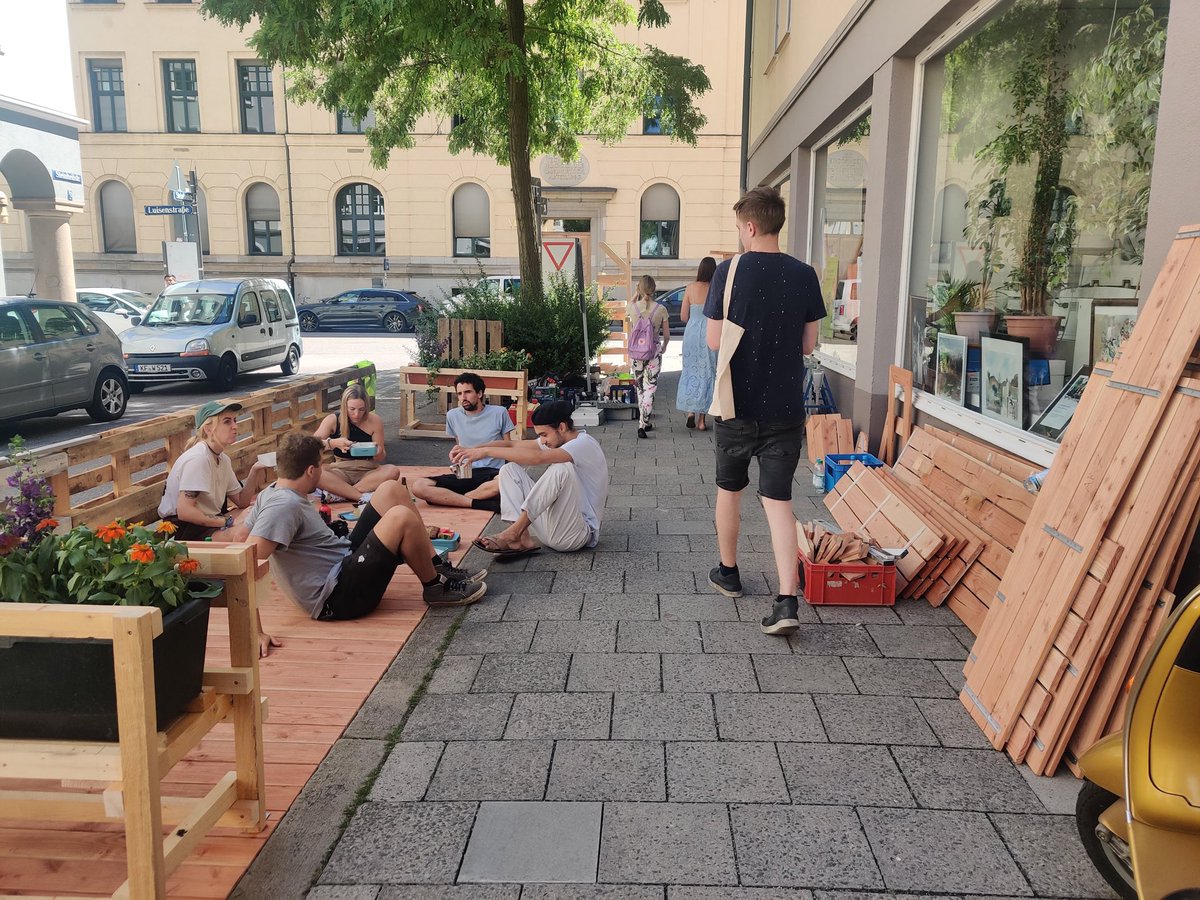
It’s an oxymoron: authoritative change without public consultation enables greater democratic participation.
Rapid change is no longer combative with the community; rather becoming collaborative - strengthening trust & producing valuable feedback for iterative improvement. 23/
Rapid change is no longer combative with the community; rather becoming collaborative - strengthening trust & producing valuable feedback for iterative improvement. 23/
Since change is tangible, projects are experienced and critiqued by actual stakeholders - including marginalized groups who are often excluded from traditional public engagement processes. By passing through the space, ALL citizens are involved in the planning process. 24/ 

This is how so many cities outside NA have created a “culture of urban change,” an acceptance that dynamism is inherent to cities. It requires both “top-down” and “bottom-up” planning - where both municipalities and their citizens feel a sense of ownership over public space. 25/
𝐃𝐚𝐭𝐚 𝐦𝐚𝐤𝐞𝐬 𝐭𝐡𝐞 𝐢𝐦𝐩𝐨𝐬𝐬𝐢𝐛𝐥𝐞, 𝐩𝐨𝐬𝐬𝐢𝐛𝐥𝐞:
Street experiments are fundamentally an exercise in data collection. The planning process becomes evidence-based and empirical - centered around MEASURABLE outcomes. 26/
Street experiments are fundamentally an exercise in data collection. The planning process becomes evidence-based and empirical - centered around MEASURABLE outcomes. 26/
https://twitter.com/RZaichkowski/status/1559187133746876416?s=20
The purpose of experiments isn’t to repurpose urban space for a few months, the goal is to create lasting and systemic change among the public & policymakers. Data is the proof in the pudding - how permanent change can be justified and detractors removed of their credibility. 27/
This intersection in Amsterdam had its traffic lights completely shut off as an experiment - to massive public controversy. Conventional wisdom would say that this move would cause chaos and traffic gridlock.
theguardian.com/environment/bi… 28/
theguardian.com/environment/bi… 28/
Robust data collection and analysis proved that road users became more aware - while traffic was reduced. Not only was this pilot successful - it was proof that the necessity of traffic controls was to be questioned when accompanied by good street design. 29/ 



This is fundamentally why street experiments are so powerful for creating permanent and lasting change. Despite being ‘temporary’, they are a concrete implementation of urban change to be EXPERIENCED, rather than just an idea or visualization to be SHOWN. 30/ 

So how can North American cities get involved in the street experiments craze? Short answer: we already have!
During COVID, cities all over the US and Canada questioned the dominance of motor vehicles, experimenting with new ways of using public space. 31/
During COVID, cities all over the US and Canada questioned the dominance of motor vehicles, experimenting with new ways of using public space. 31/
However, with the “return to normalcy,” NA cities have seemingly forgotten the successes and progress made with their pandemic-era programs. 32/
toronto.citynews.ca/2022/06/08/tor…
toronto.citynews.ca/2022/06/08/tor…
During the pandemic, Oakland blocked through traffic on nearly 21 MILES of city streets, to create safer, traffic-calmed spaces for active mobility. The program has now since completely ended - a tremendous backward step for road safety and livability 33/
sf.streetsblog.org/2022/02/15/oak…
sf.streetsblog.org/2022/02/15/oak…
What’s even more infuriating is that the dysfunctional processes plaguing NA cities have only been further reinforced post-pandemic. It’s common for NA cities to spend more resources on consultations and equity studies than actually taking action and creating positive change: 34/
American cities have a “process fetish” - where planning is not driven by empirical outcomes; rather by the appearance of equitability within the planning process.
This US planner’s takeaways from Amsterdam are quite indicative of this ideology: 35/
This US planner’s takeaways from Amsterdam are quite indicative of this ideology: 35/
https://twitter.com/StreetsblogMASS/status/1557398198771236865?s=20
It’s not so much that public participation in itself is awful; rather that systems and institutions we've designed to enable participation are fundamentally flawed. These systems create an illusion of inclusiveness while marginalizing certain groups. 36/
https://twitter.com/NimbyPatrol/status/1646971588414406656?s=20
How can we claim that NA planning processes better serve marginalized communities when environmental review is constantly weaponized to prevent construction of denser housing and rapid transit? When the privilege of public comment is only granted to those with time and money? 37/ 

There’s a valid argument to be made that foreign planners have blindspots regarding social justice - but it’s decisive that major European and Asian cities provide ALL their residents with FAR better transport, livability, and opportunity than American ones. 38/ 





It's not like endless studies and consultation produces better projects either. So many pedestrian-hostile road widenings were a direct result of months or years of public consultation meetings.
The best road designs were produced from decades of trial and error. 39/

The best road designs were produced from decades of trial and error. 39/


We can't let perfect be the enemy of the good - we don’t have the time to. There’s a climate crisis, a housing crisis, and constant traffic violence on our streets. People don’t need more studies - they need action. 40/
In our obsession with process and perfection, we’ve lost our imagination - the one thing preventing us from overcoming the car-centric status quo. 41/
The lesson here isn't that participatory planning is bad, but instead that building livable, inclusive, & sustainable cities is a *creative* exercise requiring constant revision - places that aren't scared of failure, embrace change, & empower people to imagine the impossible 42/
As the late great Kobe Bryant said, "If you're afraid of failing, you're probably going to fail."
To create truly meaningful change, we can’t be afraid to fail.
Let’s imagine a better future. Let’s do more street experiments!
To create truly meaningful change, we can’t be afraid to fail.
Let’s imagine a better future. Let’s do more street experiments!

Thank you to my friends at @RGAccessibility and @humankind for making the experience so unforgettable. 




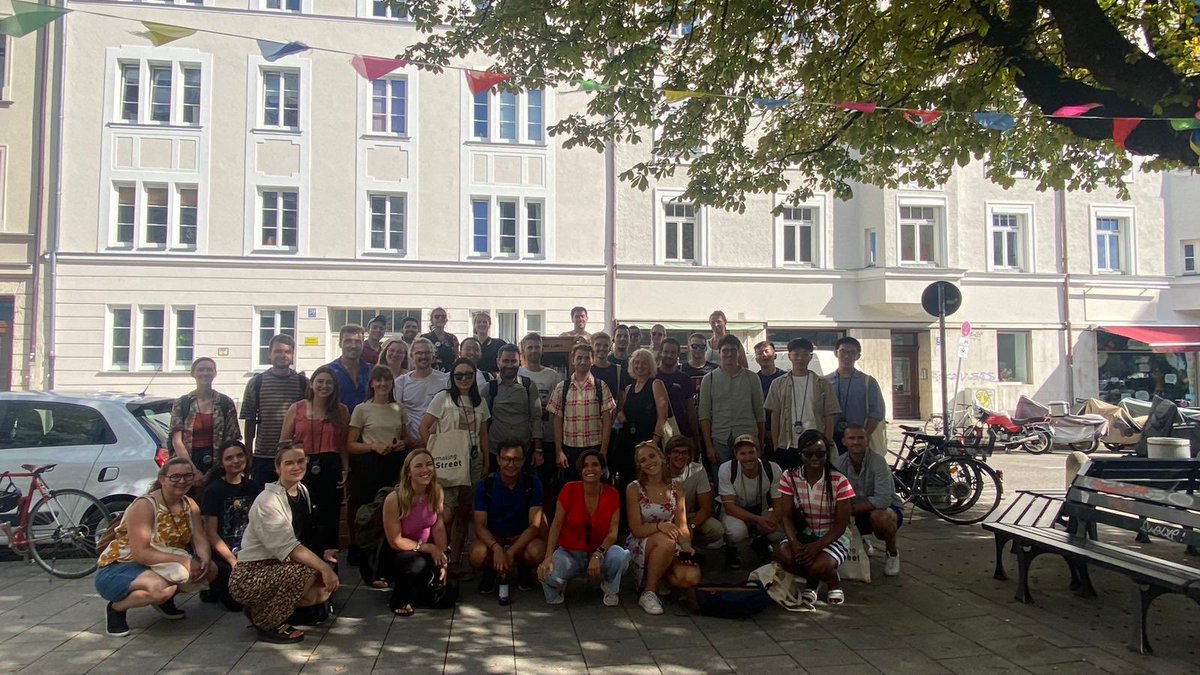
And thanks to @fietsprofessor and @EITUrbanMob for bringing me along! I’m so grateful to be able to work with such a wonderful group of people. 



If you would like to open your imagination to what’s possible with public space in our cities:
Applications are currently open for the next iteration of the Remaking the Street Summer School!
Applications are currently open for the next iteration of the Remaking the Street Summer School!
https://twitter.com/RGAccessibility/status/1638191985193525249?s=20
Thanks for reading! You can learn more about our experience from @ActiveTowns podcast with my friend & colleague, @stuttsy_ !
https://twitter.com/ActiveTowns/status/1573004338036981760?s=20
• • •
Missing some Tweet in this thread? You can try to
force a refresh

 Read on Twitter
Read on Twitter














